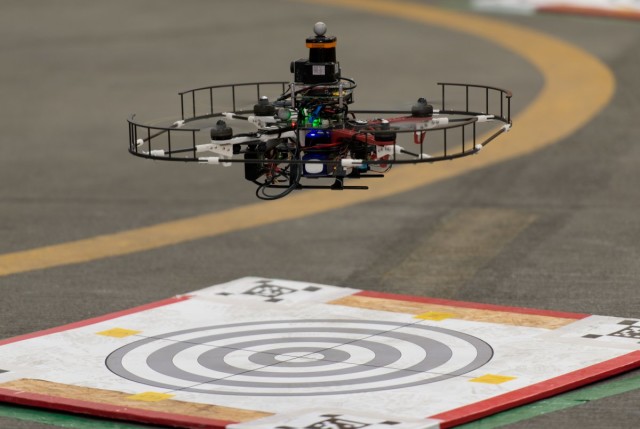Things were all abuzz at the 102nd Intelligence Wing, Jan. 18-22. The wing hosted a team of robotics experts and support personnel from the Defense Advanced Research Projects Agency on the Building 158 hangar floor to test the capabilities of the latest autonomous UAVs and sensors as part of its Fast Lightweight Autonomy program.
Created in 1958, DARPA is an agency of the DoD responsible for making pivotal investments in breakthrough technologies for national security.
The hangar provides a large enough open space to facilitate the first phase of testing of the program, which strives to achieve the capability for small, autonomous UAVs to operate in cluttered environments without the need for external communication such as GPS or human control. The DARPA team stacked cardboard boxes on the hangar floor and created a complex obstacle course in order to test the capabilities of the UAV and their human operators.
The platform that the team is using is virtually off-the-shelf. That isn’t to say you could get these UAVs at any hobby or big-box store, but the key to success of this program doesn’t sit with the airframe – it comes from the technology added to it – the advanced algorithms that enable it to navigate complicated obstacles without external influence. The key goal is to develop and test algorithms that could enable UAVs to avoid obstacles on their own, so human operators can focus on larger tasks such as supervising a group of UAVs integrated with manned aircraft as well. To achieve that end goal, FLA is developing a dexterous UAV that can move through and within disaster zones and to perform search and recovery tasks, for example, with minimal guidance from human operators while the operators remain safely out of harm’s way.
Speed is also one of the major objectives of the program. Even in the initial stages of development, these UAVs travel at quite a clip. The goal is to reach speeds of up to 45 miles per hour. Straight-line speeds of this nature are possible. But when walls, doors, and windows are factored in, it becomes far more of a challenge. The ability of these UAVs to successfully navigate, at speed, represents a major leap forward in the technology of these devices.
The primary focus of the program is of course, autonomy. That is where the team’s hard work will really pay dividends. Autonomous systems are not new. As far back as the 2004 DARPA sponsored its historic “Grand Challenge”, the first long distance competition for driverless cars in the world. Just as that program laid the groundwork for today’s driverless cars, so FLA aims to accelerate progress towards increasingly autonomous small airborne systems. As Dr. Mark Micire, Program Manager for the FLA program, points out, the first autonomous vehicles needed rack-mounted servers and big heavy sensors to make the technology work. With FLA, all that technology, used for sensing and control, needs to be light enough to be carried by small UAVs. Despite the drones’ autonomy, DARPA says there will always be a human monitoring any mission who can take over control if need be.
It is a Herculean task, but the team is up to the challenge.
Advances in commercial and military technologies are rapidly increasing the capabilities of low-cost micro and small UAVs, enabling them to carry out missions at considerably less cost and risk. And DARPA’s record is good: the Agency’s previous unmanned aircraft innovations and technology transitions have revolutionized ISR missions, ensuring not only air dominance for the DoD but also information dominance for the DoD and other agencies.
Cooperation with agencies like DARPA reinforces the forward-leaning and technology-driven persona that has grown within the 102nd Intelligence Wing in recent years.
Photo: Members of Defense Advanced Research Projects Agency’s (DARPA) Fast Lightweight Autonomy (FLA) program used the 102nd Intelligence Wing’s hangar to test small UAVs in an indoor, controlled environment.
Source: dvids

